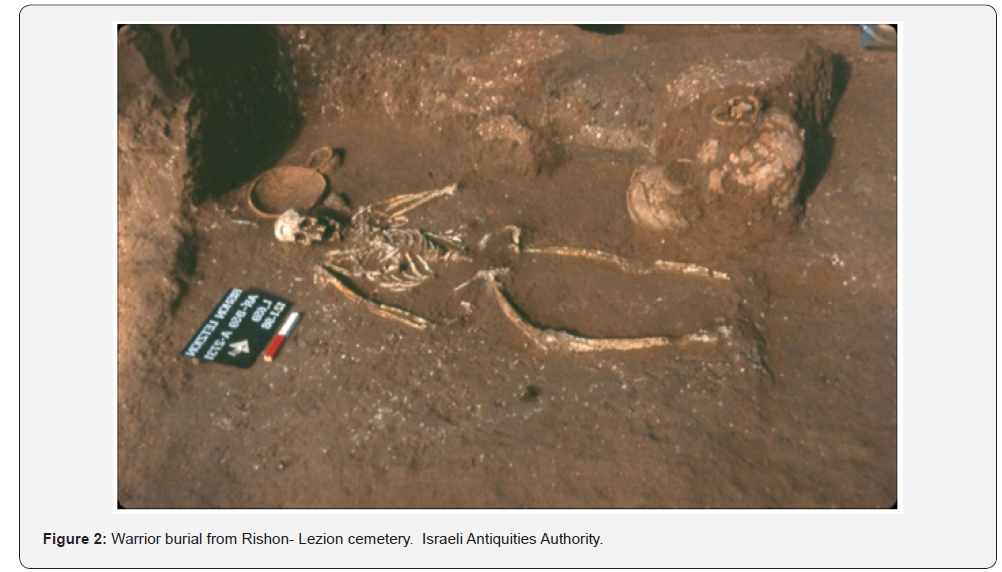Metal Weapons of “Warrior’ Burials” Found in the Middle Bronze Age II Southern Levant – Economical and Social Aspects-Juniper Publishers
Case Report and Results
More than 1000 copper-based weapons associated with the Middle Bronze Age II (MB II; ca. 1950–1550 BCE) culture have been recovered, primarily in burials, throughout the Levant (Figure 1); [1-7]. These, funerary contexts have generally been referred to as “warrior burials”, and contained individuals buried with a presumed “kit”, comprising weapons, such as daggers, axes and spearheads found on the deceased’s waist and/or next to their head (Figure 2). The “warrior burials” are dated mainly to the first half of the MBII period (MB IIA; 1950–1750 BCE) and decline in occurrence in the Middle Bronze IIB (MB IIB; 1750–1550 BCE) [6-8].


Recently, it has been shown [6,7] that less than 25% of all the MB IIA burials can be defined as “warrior burials”, and they should rather be considered to reflect high-ranking members of the contemporary society, i.e., an elite social class . The weapons in the MB IIA “warrior’ burials” were well-made, elaborate and composed of copper alloyed with up to 14% tin, both with and without low arsenic concentration [5-7].
The use of tin bronzes is considered the most important technological innovation of the Middle Bronze Age II (MBII). Tin Bronze objects are known from earlier periods, but in small quantities while the use of arsenic copper was more common [5,9]. During the Middle Bronze Age II, tin bronze was widely used to create metal objects in general and weapons [5,6,7,10]. While for production of arsenic copper one metal source containing copper with arsenic was needed, the production of tin bronze required two metal sources, one of tin and one of copper, which were in far distance from the southern Levant [11,12]. Nevertheless, no tin sources were found in the Levant and there is no evidence that local copper sources were exploited at this time, in contrast to the former periods [13-15]. In addition, almost no ingots and complete workshops from this period were found in the Levant [1,2,14-16]. This raise a series of significant questions concerning the factors that led to the widespread use of tin bronzes at this period, the sources of copper and tin, and the trading systems that brought the raw materials and the finished products to the Levant.
In addition, to date, the transition from the use of arsenical copper to tin bronze was perceived as a linear development; It was assumed that at the beginning of the Middle Bronze Age (MBIIA), most weapons, in continuation of the former period, were made of arsenical copper, while in the later part of the period (MBIIB), most of the weapons were made of tin bronze [5]. Through a detailed analysis of the available metallurgical data we have shown that the situation was in fact quite the opposite. It was demonstrated that the transition was highly complex; Tin bronze appeared quite abruptly in the MBIIA, with only few antecedents, and decreased during the MBIIB [6,7].
Discussion
Therefore, gradual linear development cannot explain this transition, but rather social circumstances that are to the MBIIA as well as developments in the wider region, including the development of trade networks that enabled the transport of the necessary raw materials – copper and tin. Trade routes that connected Mesopotamia with Anatolia as well as the Levant in the early second millennium are known from both texts and archaeological evidence. The Mari and Kultepe-Kanish archives dated to the MBIIA support this picture of long-distance trade connections and provide some information on the metal supply system during this period, mainly of copper and tin [12,17]. Through these trade routes, the social concepts of the “Warrior’ burials” could penetrate the southern Levant, as burials of high rank members in the society with elevated status. In the MBIIB, with the increased Asiatic presence in the eastern part of the Egyptian Delta, trade contacts with Anatolia decreased [18-22].
Thus, these extensive political and socio-economic changes in the MBII period may explain the change in availability of raw materials and metal products and should be further explored.
https://juniperpublishers.com/gjaa/GJAA.MS.ID.555676.php
For More Articles in Archaeology & Anthropology Please Click on: https://juniperpublishers.com/gjaa/index.php
For More Open Access Journals In Juniper Publishers Please click on: https://juniperpublishers.com/index.php
For more queries Juniper publishers please click on: https://www.quora.com/Is-Juniper-Publisher-a-good-journal-to-publish-my-paper




Comments
Post a Comment